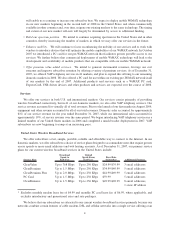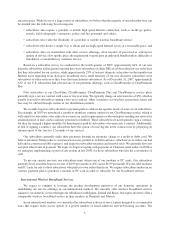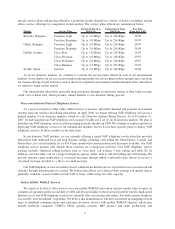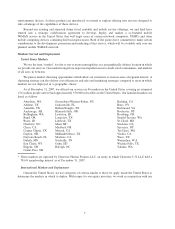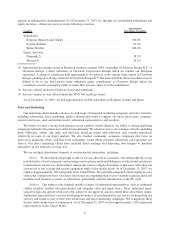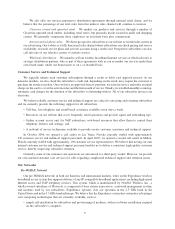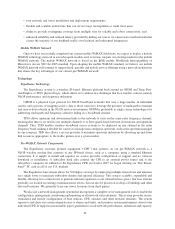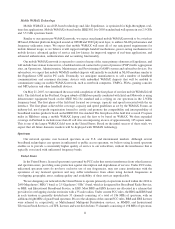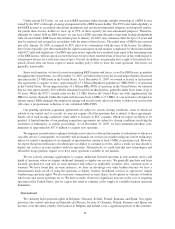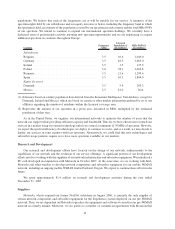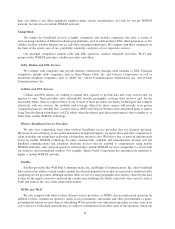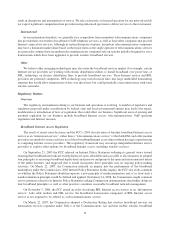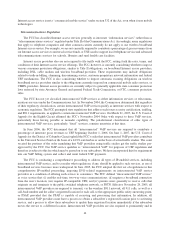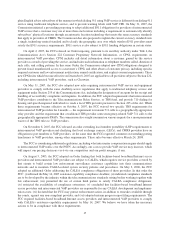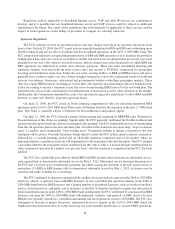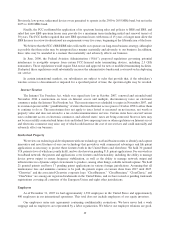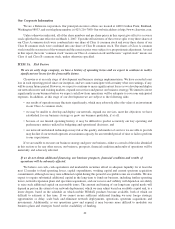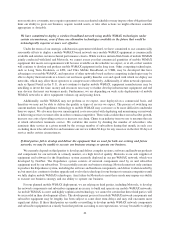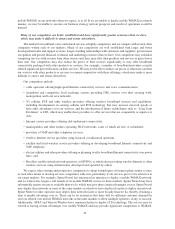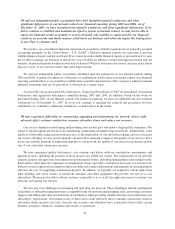Clearwire 2007 Annual Report Download - page 22
Download and view the complete annual report
Please find page 22 of the 2007 Clearwire annual report below. You can navigate through the pages in the report by either clicking on the pages listed below, or by using the keyword search tool below to find specific information within the annual report.limit our ability to use other equipment suppliers under certain circumstances, not only for our pre-WiMAX
network, but also for our mobile WiMAX network.
Competition
The market for broadband services is highly competitive and includes companies that offer a variety of
services using a number of different technological platforms, such as cable modems, DSL, third-generation, or 3G,
cellular, satellite, wireless Internet service and other emerging technologies. We compete with these companies on
the basis of the speed, ease of use, portability, reliability, and price of our respective services.
Our principal competitors include cable and DSL operators, wireless telephone providers, Wi-Fi and,
prospectively, WiMAX providers, satellite providers and others.
Cable Modem and DSL Services
We compete with companies that provide Internet connectivity through cable modems or DSL. Principal
competitors include cable companies, such as Time Warner Cable, Inc. and Comcast Corporation, as well as
incumbent telephone companies, such as AT&T Inc., Qwest Communications International, Inc. and Verizon
Communications, Inc.
Cellular and PCS Services
Cellular and PCS carriers are seeking to expand their capacity to provide data and voice services that are
superior to ours. These providers have substantially broader geographic coverage than we have and, for the
foreseeable future, than we expect to have. If one or more of these providers can deploy technologies that compete
effectively with our services, the mobility and coverage offered by these carriers will provide even greater
competition than we currently face. Carriers such as AT&T and Verizon Wireless have announced plans to deploy
Long Term Evolution technologies, or LTE, which, when developed, may deliver performance that is similar to, or
better than, mobile WiMAX technology.
Wireless Broadband Service Providers
We also face competition from other wireless broadband service providers that use licensed spectrum.
Moreover, if our technology is successful and garners widespread support, we expect these and other competitors to
adopt or modify our technology or develop a technology similar to ours. We believe that, as network infrastructure
based on mobile WiMAX technology becomes commercially available and manufacturers develop and sell
handheld communications and consumer electronic devices that are enabled to communicate using mobile
WiMAX networks, other network operators will introduce mobile WiMAX services comparable to ours in both
our domestic and international markets. For example, Sprint Nextel Corporation has announced its intention to
deploy a mobile WiMAX network.
Satellite
Satellite providers like Wild Blue Communications, Inc. and Hughes Communications, Inc. offer broadband
data services that address a niche market, mainly less densely populated areas that are unserved or underserved by
competing service providers. Although satellite offers service to a large geographic area, latency caused by the time
it takes for the signal to travel to and from the satellite may challenge the ability to provide some services, such as
VoIP, and reduces the size of the addressable market.
WISPs and Wi-Fi
We also compete with other wireless Internet service providers, or WISPs, that use unlicensed spectrum. In
addition to these commercial operators, many local governments, universities and other governmental or quasi-
governmental entities are providing or subsidizing Wi-Fi networks over unlicensed spectrum, in some cases at no
cost to the user. Unlicensed spectrum may be subject to interference from other users of the spectrum, which can
14


